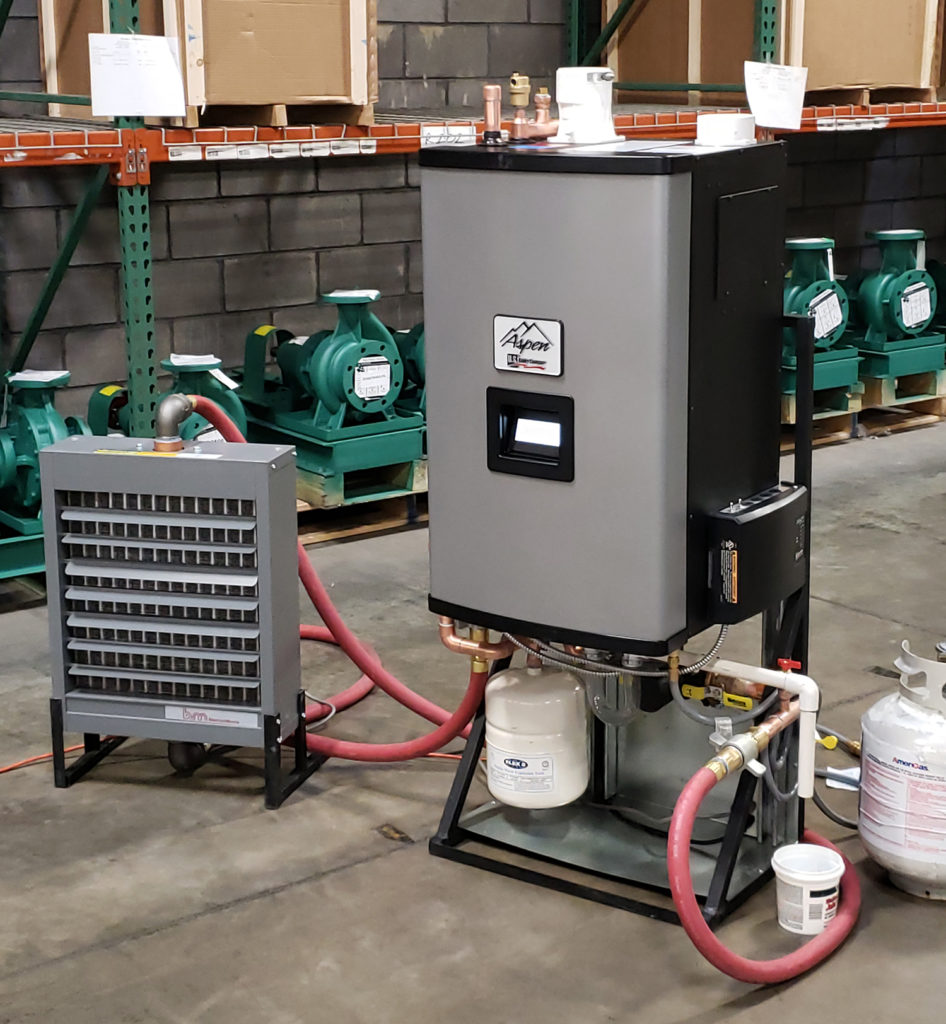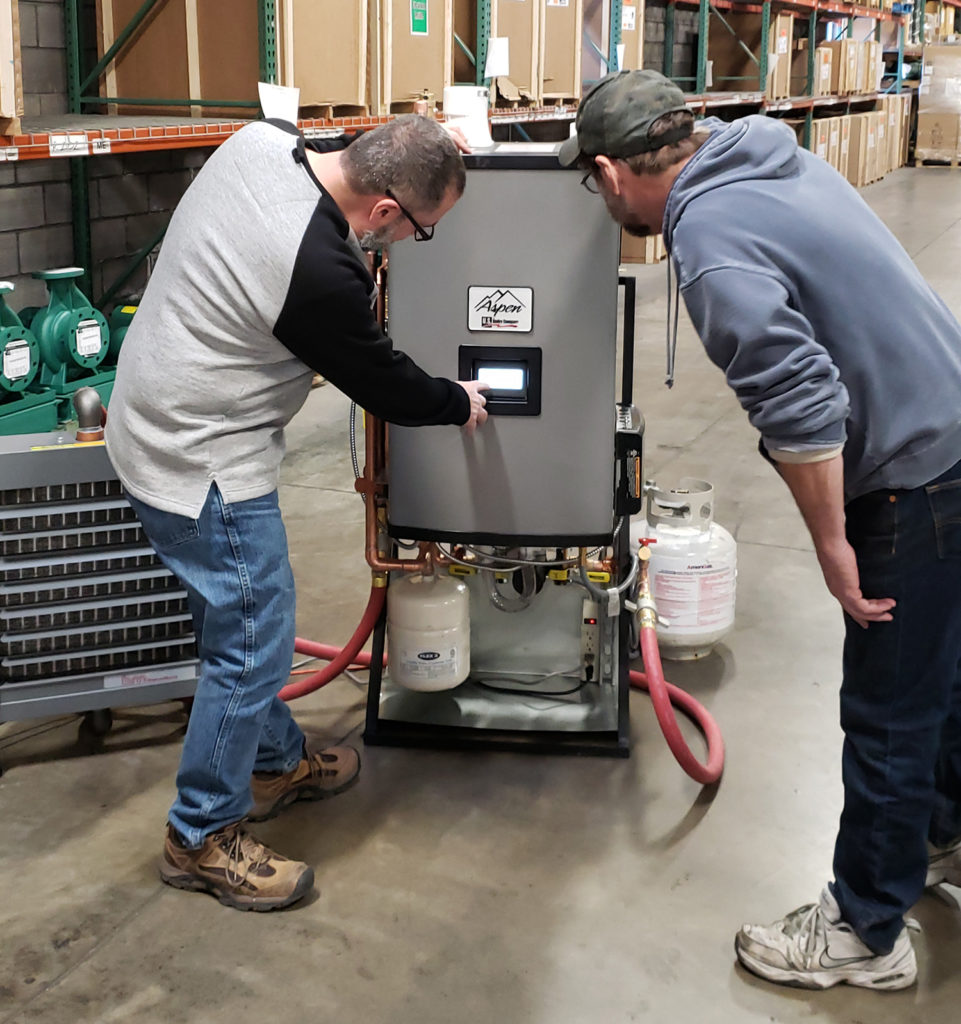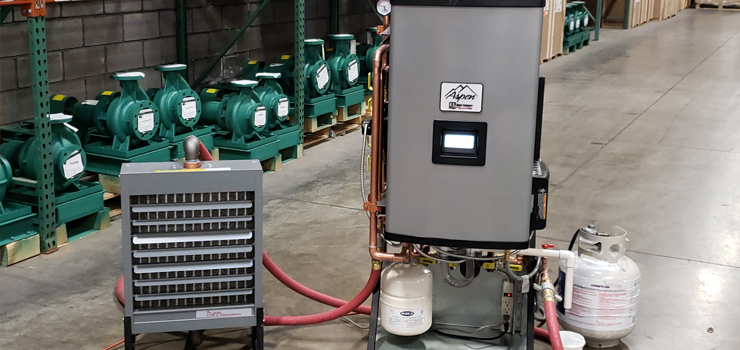Among the services a manufacturer’s representative can provide to an HVAC contractor, few are as valuable as training.
If the training is mobile, even better. After all, it’s easier for one rep to travel to the contractor’s place of business than to have a whole crew of technicians drive to the rep’s office, on the clock both ways. The drawback to mobile training, typically, is the inability to live-fire equipment. So McCoy Sales, in Denver, CO, came up with an atypical solution.
Early this year, sales rep Chris McLaughin assembled a portable, live-fire boiler system. If features a fully-functional, 85,000 BTUh U.S. Boiler Aspen condensing boiler, primary/secondary piping, Sage Zone Control and radiation in the form of a 70,000 BTUh Beacon Morris fan coil unit. The system fits in a five-foot pickup truck bed and is fueled by a 20 pound propane cylinder – literally a grill tank.
“It’s a training tool, and our goal is simply to show contractors how simple hydronic systems can be,” said McCoy Sales’ Mark Doyle. “We’ve only had the ability to provide live-fire training at our office until now. On the road, we’ve been limited to training on a powered boiler display. This takes training up 10 notches! We have a portable boiler room… The only thing we can’t replicate is the use of multiple zones.”

Above: The mobile live fire boiler system includes an 85 MBH Aspen boiler, Sage Zone Control and a 70,000 BTUh fan coil unit.
That doesn’t seem to matter one bit, though, because the feedback has been 100% positive. The mobile boiler’s first training mission was to Laramie, WY, where Doyle spent a full morning with five technicians at All In One Plumbing.
“They asked if we provided training, so I drove about three hours to their shop with the boiler and propane tank in the back of my Toyota Tacoma,” said Doyle. “Even though we used the Aspen, the material we covered wasn’t model-specific.”
Doyle presented a general boiler training program, which included primary-secondary piping (and bypass piping for cast iron boilers), venting, condensate removal, and sizing of pipe and pumps. He also went through the differences between wiring schematics and ladder diagrams and how to read them.
The Sage Zone Control is included so that trainers can display how easy it is to provide multiple supply water temperatures, such as DHW, a high-temp baseboard loop and low-temp in-floor zones.
“The techs were impressed that we can create real-world scenarios,” said Doyle. “What’s nice about live-fire training is that you can actually see the intuitiveness and ease of programming the Sage 2 control. From Delta T graphs and temperatures to system settings and watching the boiler modulate. Status screens changing as well as sequence of operation on the boiler display. Attendees can also see how to perform a true combustion test. You can’t do that with a powered display.”

Above: Ray Gallegos, McCoy Sales general manager, walks through the menu on the live-fire boiler with Mark Nelson, warehouse manager and pump technician.
“Chris did an amazing job building this unit,” continued Doyle. “It looks fantastic and functions like a dream. He’s from the trade, and his attention to detail is readily apparent.”
Build it, and they won’t have to come
“Everyone in this industry is busy,” said McLaughlin. “Their time is valuable and they can’t afford to spend half a day on the road getting to a training session. Our territory is very big, so we needed a way for our trainers to close the gap. The mobile boiler is the answer.
McLaughlin started with one-inch steel square tube to create frame, or chassis. The whole assembly couldn’t exceed five feet long or 30 inches wide. The Aspen boiler, Sage Zone Control, circulators, expansion tank and all piping (including closely-spaced tees) are mounted on the frame. The boiler and fan coil are plugged into a power strip and pigtail. If a facility has 110-watt power, training can commence!
The fan coil unit is separate, but thanks to quick-disconnect fittings, it can be added or removed without losing system charge. Freezing temperatures during transport or storage were taken into account. The hydronic fluid is 50% glycol. All told, the mobile boiler system weighs about 150 lbs.
“Essentially, it’s a pre-fabricated boiler system,” said McLaughlin. “If you pull six screws out of the frame, this whole system is ready to hang on a wall. It could, in theory, even be used as an emergency source of hydronic heat, if it was sheltered outside or vented properly indoors. Contractors have even asked if they can buy boilers like this from us.”
Down the road
“We could probably have the live-fire Aspen booked out initially for one training session a week, but as time progresses, additional visits per week will be added, said Doyle. “In addition to in-house training, there’s been interest for open houses and counter days. I’m sure there will even be possibilities we haven’t considered yet.”
McCoy may also build a portable, live-fire K2 Combi boiler later this year. In the meanwhile, contractors in Colorado, New Mexico, Utah, Wyoming, western South Dakota and western Nebraska have a great new option to get up to speed on cutting-edge hydronic technology.
If you’re in that part of the country and you want to schedule a live fire demo and/or training, call Mark Doyle (McCoy Sales) at 720-218-2609 today!

